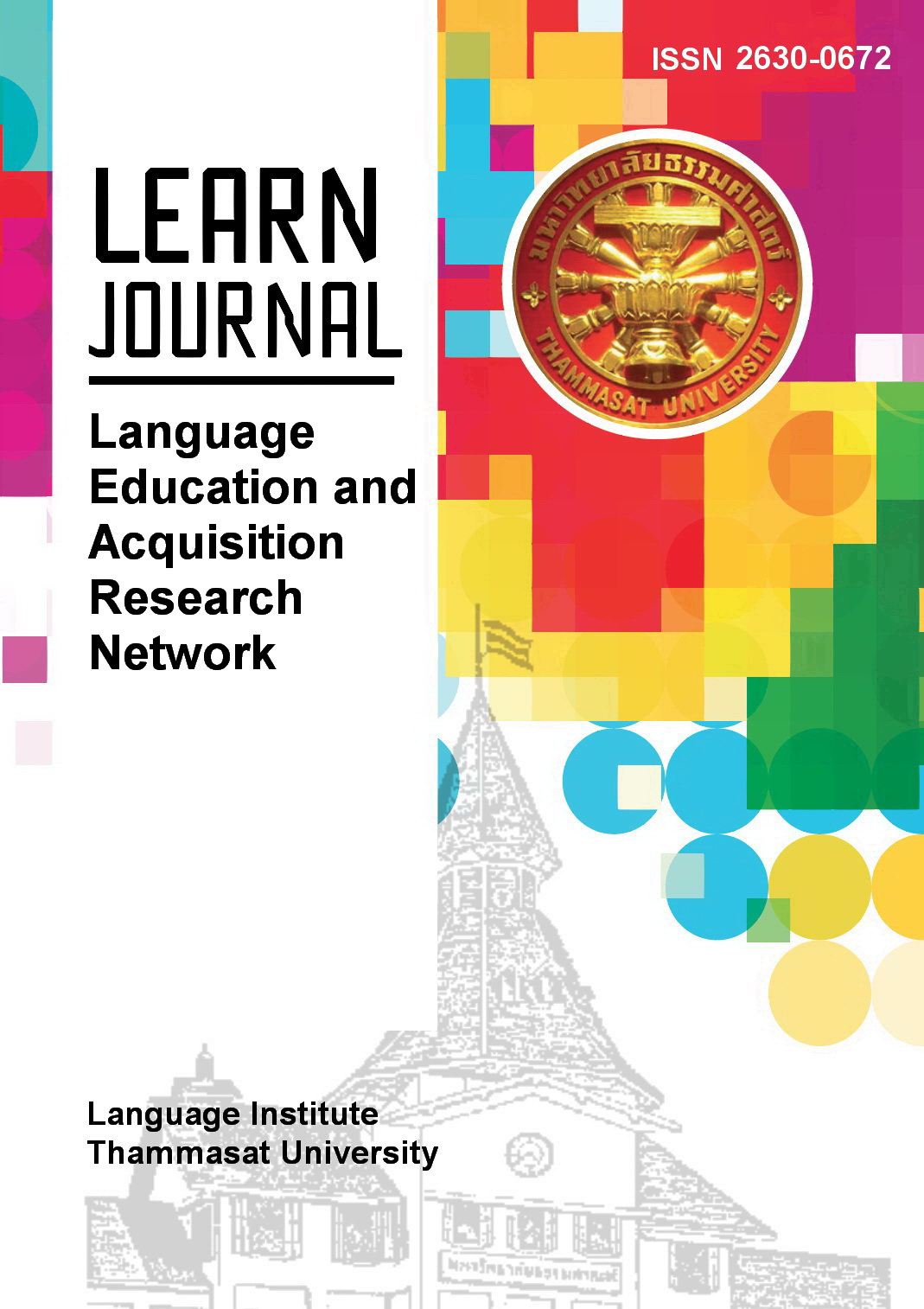Thai Learners’ Acquisition of English Dative Constructions: Evidence for the Absence of L1 Transfer
Main Article Content
Abstract
This study investigated Thai EFL learners’ acquisition of English dative constructions, i.e., Prepositional Dative (PD) and Double Object (DO) constructions employing Radford’s (2004) Minimalist accounts as a framework and Acceptability Judgment as a task. Two hypotheses were formulated. Firstly, the English PD would be accepted more readily than the English DO, due to the availability of PDs in both languages and the absence of DOs, by English standards, in Thai. Secondly, if there was L1 transfer, English counterparts of Thai DO and Thai Serial Verb constructions (SVC) would be initially accepted at a greater rate than English DOs. At later stages, given access to UG and adequate L2 input, the English DO would be accepted more significantly than the Thai DO and Thai SVC. Participants consisted of three groups of Thai EFL learners (beginning, intermediate, and upper intermediate). Results largely confirm both hypotheses. Particularly, Thai DOs and SVCs were rejected substantially from the intermediate learners onwards. This shows that the initial transfer of Thai DO and SVCs did not occur. Therefore, this study does not support Full Transfer at the initial stage (contra Schwartz & Sprouse, 1996). This study suggests L2 learners’ indecision on the target L2 structure at the early stage and progress to attainment at later stages, in line with Wakabayashi’s Lexical Learning and Lexical Transfer hypothesis (2009), and accessibility to UG at large.
Article Details
References
Baker, M. C. (1988). Incorporation. A theory of grammatical function changing. University of Chicago Press.
Baker, M. C. (2013). Agreement and case. In M. den Dikken (Ed.), The Cambridge handbook of generative syntax (pp. 578-607). Cambridge University Press.
Chomsky, N. (1955/1975). The logical structure of linguistic theory. University of Chicago Press.
Chomsky, N. (1995). The Minimalist Program. MIT Press.
Carrier-Duncan, J. (1985). Linking of thematic roles in derivational word formation, Linguistic Inquiry, 16, 1-34.
Hale, K., & Keyser, S. J. (1993). On argument structure and the lexical expression of syntactic relations. In K. Hale, S. J. Keyser (Eds.), The view from building 20: Essays in linguistics in honor of Sylvain Bromberger (Current Studies in Linguistics 24) (pp. 53-109). MIT Press.
Hornstein, N., Nunes, J., & Grohmann, K. K. (2006). Understanding Minimalism. Cambridge University Press.
Inagaki, S. (1997). Japanese and Chinese learners' acquisition of the narrow‐range rules for the dative alternation in English. Language Learning, 47(4), 637-669.
Kerr, P., Jones, C., Norris, R., Jeffries, A., & Mauchline, F. (2012). Quick placement test: In straightforward. Second Edition. Macmillan Education. http://www.macmillanstraightforward.com/resources/tests.
Koenig, J-P., & Muansuwan. N. (2005). The syntax of aspect in Thai. Natural Language & Linguistic Theory 23(2), 335–380.
Koopman, H., & Sportiche, D. (1991). The position of subjects. Lingua 85, 211-258.
Larson, R. K. (1988). On the double object construction. Linguistic Inquiry 19, 595-621.
Muansuwan, N. (2002). Verb complexes in Thai. Doctoral dissertation. The State University of New York at Buffalo. https://arts-sciences.buffalo.edu/content/dam/arts-sciences/linguistics/AlumniDissertations/Muansuwan%20dissertation.pdf
Oh, E., & Zubizarreta, M. L. (2005). The asymmetric behavior of goal and benefactive double objects in the English interlanguage of adult L1 Korean and L1 Japanese speakers. In L. Dekydtspotter, R. A. Sprouse, & A. Liljestrand (Eds.), Proceedings of the 7th Generative Approaches to Second Language Acquisition Conference (GASLA 2004) (pp.193-204). Cascadilla Proceedings Project.
Radford, A. (2004). English syntax. Cambridge University Press.
Pinker, S. (1989). Language learnability and language development, with new commentary by the author (Vol. 7). Harvard University Press.
Schwartz, B. D. & Sprouse, R. (1996). L2 cognitive states and the full transfer/full access model. Second Language Research, 12, 40–72.
Simpson, A. (2001). Focus, presupposition, and light predicate raising in East and Southeast Asia. Journal of East Asian Linguistics, 10, 89-128.
Singhapreecha, P., & Sybesma, R. (2015). An ellipsis analysis of split nominals in Thai. Cahiers de Linguistique Asie Orientale, 44(1), 57-88.
Snyder, W. & K. Stromswold (1997). The structure and acquisition of English dative constructions. Linguistic Inquiry, 28, 281-317.
Sudmuk, C. (2005). The syntax and semantics of serial verb constructions in Thai. Doctoral dissertation, University of Texas at Austin. https://repositories.lib.utexas.edu/bitstream/handle/2152/2112/sudmukd95920.pdf?sequence=2&isAllowed=y
Teeranate, K., & Singhapreecha, P. (2022). Control before raising in Thai EFL Grammar. LEARN Journal: Language Education and Acquisition Research Network, 15(1), 588-626. https://so04.tcithaijo.org/index.php/LEARN/article/view/256739/174243
Wakabayashi, S. (2009). Lexical learning in second language acquisition: optionality in the numeration. Second Language Research 25(2), 335-341.
Whong-Barr, M., & Schwartz, B. D. (2002). Morphological and syntactic transfer in child L2 acquisition of the English dative alternation. Studies in Second Language Acquisition, 24(4), 579-616.
Yoshimura, N., Nakayama, M., Fujimori, A., & Shimizu, H. (2016). Control and raising constructions in early L2 English acquisition. Second Language, 15, 53-76.


